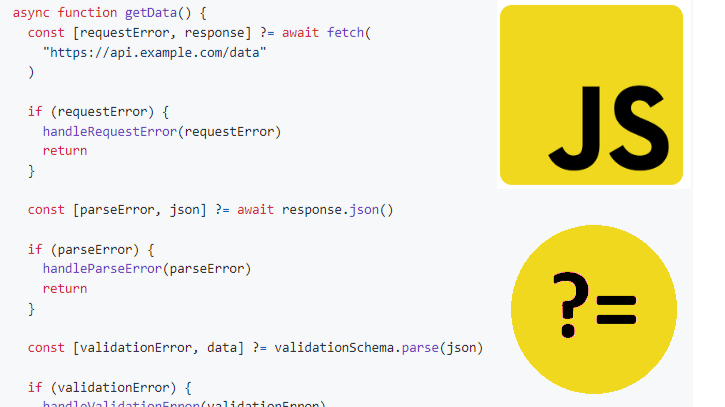
Introducing the ECMAScript Safe Assignment Operator: Simplifying Error Handling in JavaScript
Adrian Birta
React Front-end Developer ? Contractor ? Freelancer | I help companies design and implement scalable software products
Warning - This proposal is actively under development!
JavaScript is evolving, and one of the most exciting proposals currently under development is the ECMAScript Safe Assignment Operator (?=). If you've ever found yourself tangled in a web of try-catch blocks or struggled with handling errors in promises, this new operator might just be the game-changer you’ve been waiting for.
What is the Safe Assignment Operator (?=)?
The Safe Assignment Operator (`?=`) is a proposed addition to the ECMAScript specification, designed to simplify error handling in JavaScript. It transforms the result of a function into a tuple (an array with two elements). If the function executes successfully, it returns `[null, result]`. However, if an error is thrown, it returns `[error, null]`. This structured approach is compatible with promises, asynchronous functions, and any value that implements the `Symbol.result` method.
Why Do We Need It?
Error handling in modern JavaScript, especially when dealing with asynchronous operations, can quickly become complex and unwieldy. A typical async function might look something like this:
async function getData() {
try {
const response = await fetch("https://api.example.com/data");
const json = await response.json();
return validationSchema.parse(json);
} catch (error) {
handleError(error);
}
}
This code works, but it's easy to see how it can become messy and error-prone. Each step in the process—fetching data, parsing JSON, and validating the result—can fail in multiple ways. Without careful error handling, these failures can lead to unexpected crashes or silent failures, making debugging a nightmare.
Enter the Safe Assignment Operator
The `?=` operator streamlines this process by wrapping each potential failure point in a neat, readable package:
async function getData() {
const [requestError, response] ?= await fetch("https://api.example.com/data");
if (requestError) {
handleRequestError(requestError);
return;
}
const [parseError, json] ?= await response.json();
if (parseError) {
handleParseError(parseError);
return;
}
const [validationError, data] ?= validationSchema.parse(json);
if (validationError) {
handleValidationError(validationError);
return;
}
return data;
}
With the `?=` operator, each function call's potential error is captured and handled immediately, eliminating the need for multiple nested `try-catch` blocks. This not only enhances code readability but also makes error handling more consistent and reliable across your codebase.
Key Features of the Proposal
The Safe Assignment Operator comes with several powerful features that make it a valuable addition to JavaScript:
领英推荐
Why Not data First?
You might wonder why the error is placed first in the tuple, rather than the data, as is common in other languages like Go. The rationale is simple: in JavaScript, error handling should take precedence. By placing the error first, the `?=` operator ensures that developers cannot ignore potential issues—a critical feature for robust, secure applications.
This Proposal Is Actively Under Development
It's important to note that this proposal is still actively under development. The authors, including Arthur Fiorette , have been working tirelessly to refine the concept and ensure it integrates smoothly into the JavaScript ecosystem. Contributions and feedback from the developer community are welcome and encouraged as the proposal continues to evolve. You can follow the development and contribute your ideas on Arthur Fiorette's GitHub repository .
Limitations and Future Work
While the `?=` operator offers a significant step forward in error handling, it’s not without its limitations. For instance, it doesn’t impose strict type enforcement on errors or handle errors automatically. Developers will still need to write the necessary code to manage errors effectively.
Additionally, some aspects of the proposal, such as the nomenclature for `Symbol.result` methods, require further refinement. The behavior of this within the context of `Symbol.result` and the integration with finally blocks are also areas that need more exploration.
Conclusion
The ECMAScript Safe Assignment Operator (`?=`) is an exciting new proposal that promises to simplify error handling in JavaScript, making your code more readable, consistent, and secure. By transforming error-prone asynchronous code into a clear, structured format, it addresses many of the challenges that developers face today.
As this proposal continues to evolve, there’s still time to contribute your thoughts and ideas. Whether you’re a seasoned developer or just getting started, the Safe Assignment Operator is a feature worth keeping an eye on—it could soon become a staple in your JavaScript toolkit.
A Grateful Acknowledgment
Special thanks to Arthur Fiorette and the other contributors who are driving this proposal forward. Their innovative thinking and dedication to improving JavaScript are paving the way for a more robust and developer-friendly language. Your work is truly appreciated! If you'd like to learn more or get involved, be sure to check out the GitHub repository for the latest updates.
Chief Operating Officer - reinteractive | Ruby & AI Specialists
2 个月Hi there, which AI LLM did you use to write this article? The reason I know is the use of cliched language (game-changer, enter ...) etc